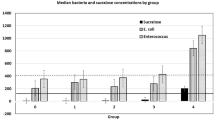Abstract
Nonpoint source pollution is the leading remaining cause of water quality problems. The extent of NPS pollution is often more difficult or expensive to monitor at the point(s) of origin, as compared to monitoring of point sources. This study evaluated the hypothesis that animal manure (chicken, cow, horse, and pig) applied to pasture contribute fecal sterols and bile acids to runoff. The study also assessed the potential benefit of fecal sterols and bile acids as biomarkers in distinguishing fecal pollution and its sources. Fecal sterol and bile acid concentrations were determined in flow-weighted composite runoff samples collected from 2.4 × 6.1 m plots (n = 3) amended with manure. Runoff was generated from simulated rainfall (152 mm.h−1). Runoff samples from manure-amended plots showed high concentrations of fecal sterol (ranged from 13 ± 1 to 1,287 ± 183) and bile acid (ranged from 24 ± 1 to 2,251 ± 248) biomarkers. The profiles of fecal sterols and bile acids in runoff samples were similar to those of fresh manure for all selected animals. For runoff and fresh manure, chenodeoxycholic acid, deoxycholic acid, epicoprostanol, and hyodeoxycholic acid were consistent biomarkers for chicken, cow, horse, and pig, respectively, suggesting that sterols and bile acids can be used to identify sources and occurrence of fecal matter in water and sediments.






Similar content being viewed by others
References
Bull, I. D., Elhmmali, M. M., Roberts, D. J., & Evershed, R. P. (2003). The application of steroidal biomarkers to track the abandonment of a Roman wastewater course at the Agora (Athens, Greece). Archaeometry, 45, 149–161. doi:10.1111/1475-4754.00101.
Bull, I. D., Lockheart, M. J., Elhmmali, M. M., Roberts, D. J., & Evershed, R. P. (2002). The origin of faeces by means of biomarker detection. Environment International, 27, 647–654. doi:10.1016/S0160-4120(01)00124-6.
Busheé, E. L., Edwards, D. R., & Moore, P. A. (1998). Quality of runoff from plots treated with municipal sludge and horse bedding. Transactions of the ASAE. American Society of Agricultural Engineers, 41, 1035–1041.
Chaler, R., Simoneit, B. R. T., & Grimalt, J. O. (2001). Bile acids and sterols in urban sewage treatment plants. Journal of Chromatography. A, 927, 155–160. doi:10.1016/S0021-9673(01)01086-X.
Elhmmali, M. M., Roberts, D. J., & Evershed, R. P. (1997). Bile acids as a new class of sewage pollution indicator. Environmental Science and Technology, 31, 3663–3668. doi:10.1021/es9704040.
Elhmmali, M. M., Roberts, D. J., & Evershed, R. P. (2000). Combined analysis of bile acids and sterols/stanols from riverine particulates to assess sewage discharges and other fecal sources. Environmental Science and Technology, 34, 39–46. doi:10.1021/es990076z.
Evershed, R. P., & Bethell, P. H. (1996). Application of multimolecular biomarker techniques to the identification of fecal material in archaeological soils and sediments. ACS Symposium Series. American Chemical Society, 625, 157–172.
Haslewood, G. A. D. (1967). Bile salts. London: Methuem.
Jarde, E., Gruau, G., Mansuy-Huault, L., Peu, P., & Martinez, J. (2007). Using sterols to detect pig slurry contribution to soil organic matter. Water, Air, and Soil Pollution, 178, 169–178. doi:10.1007/s11270-006-9188-9.
Leeming, R., Ball, A., Ashbolt, N., & Nichols, P. (1996). Using faecal sterols from humans and animals to distinguish faecal pollution in receiving waters. Water Research, 30, 2893–2900. doi:10.1016/S0043-1354(96)00011-5.
Maldonado, C., Venkatesan, M. I., Phillips, C. R., & Bayona, J. M. (2000). Distribution of trialkylamines and coprostanol in San Pedro Shelf sediments adjacent to a sewage outfall. Marine Pollution Bulletin, 40, 680–687. doi:10.1016/S0025-326X(00)00002-3.
Nash, D., Leeming, R., Clemow, L., Hannah, M., Halliwell, D., & Allen, D. (2005). Quantitative determination of sterols and other alcohols in overland flow from grazing land and possible source materials. Water Research, 39, 2964–2978. doi:10.1016/j.watres.2005.04.063.
NRCS (1992). ‘Agricultural waste management field handbook.’. Washington, DC: USDA-NRCS.
Peng, X. Z., Zhang, G., Mai, B. X., Hu, J. F., Li, K. C., & Wang, Z. D. (2005). Tracing anthropogenic contamination in the Pearl River estuarine and marine environment of South China Sea using sterols and other organic molecular markers. Marine Pollution Bulletin, 50, 856–865.
Setchell, K. D. R., Lawson, A. M., Tanida, N., & Sjovall, J. (1983). General methods for the analysis of metabolic profiles of bile acids and related compounds in feces. Journal of Lipid Research, 24, 1085–1100.
Simpson, I. A., van Bergen, P. F., Perret, V., Elhmmali, M. M., Roberts, D. J., & Evershed, R. P. (1999). Lipid biomarkers of manuring practice in relict anthropogenic soils. The Holocene, 9, 223–229. doi:10.1191/095968399666898333.
Tyagi, P., Edwards, D. R., & Coyne, M. S. (2008). Use of sterol and bile acid biomarkers to identify domesticated animal sources of fecal pollution. Water, Air, and Soil Pollution, 187, 263–274. doi:10.1007/s11270-007-9514-x.
Venkatesan, M. I., & Kaplan, I. R. (1990). Sedimentary coprostanol as an index of sewage addition in Santa-Monica Basin, Southern-California. Environmental Science and Technology, 24, 208–214. doi:10.1021/es00072a009.
Venkatesan, M. I., Ruth, E., & Kaplan, I. R. (1986). Coprostanols in Antarctic marine-sediments—a biomarker for marine mammals and not human pollution. Marine Pollution Bulletin, 17, 554–557. doi:10.1016/0025-326X(86)90569-2.
Acknowledgement
We acknowledge the Kentucky Agricultural Experiment Station, University of Kentucky, USA for funding this work; the individuals who collected the fecal and runoff samples, and the associated departments for allowing the fecal samples to be part of this work. John May (lab technician) of ERTL, UKY is thanked for his technical assistance in using GC–MS.
Author information
Authors and Affiliations
Corresponding author
Rights and permissions
About this article
Cite this article
Tyagi, P., Edwards, D.R. & Coyne, M.S. Fecal Sterol and Bile Acid Biomarkers: Runoff Concentrations in Animal Waste-Amended Pastures. Water Air Soil Pollut 198, 45–54 (2009). https://doi.org/10.1007/s11270-008-9824-7
Received:
Accepted:
Published:
Issue Date:
DOI: https://doi.org/10.1007/s11270-008-9824-7




